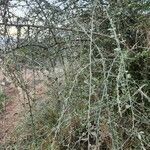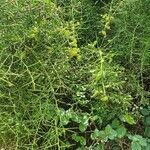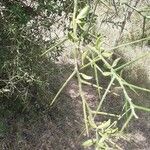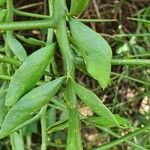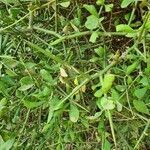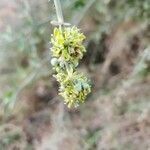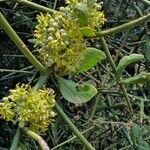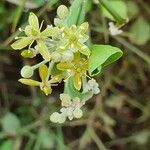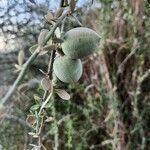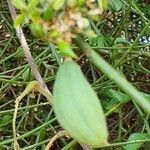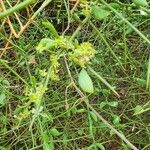Very spiny evergreen shrub or small tree up to 9 m high, rarely taller, ± erect, sometimes drooping, rarely ‘creeping’ (Napier 2354) or subscandent; bark grey or grey-green, rough, corky, corrugated and fissured; branches smooth, yellowish green to dark green; branchlets and immature spines green, at first adpressed-puberulous, glabrescent, the second-year stems very sparsely hairy, sometimes glaucous.. Spines borne at right-angles to the parent stem 5–20(–30) mm above the axil, 3–13 cm long, 2–3.5 mm diameter, sometimes bearing branch-spines, very stout, terete, yellowish-green, the spine-tip often orange-brown; spinules absent.. Scale-leaves 2 mm long, 1 mm wide, triangular, acute, scarious, sometimes persistent.. Leaves infrequent, subsessile or with a petiole up to 1–2.5 mm long; stipules 1 mm long, very early caducous; leaflets elliptic, obovate or obovate-spathulate, sessile, 2.2–6.2 cm long, 1.2–3.8 cm wide, apex rounded, obtuse or acute, sometimes minutely apiculate, base cuneate, thinly coriaceous, glabrous above, often very sparsely adpressed puberulous below; foliole 1–2 mm long, linear, rarely foliar and to 1.7 cm long, 0.4 cm wide.. Inflorescence generally on the spines, but sometimes on the parent axis, fasciculate; pedicels 3.5–10 mm long, densely white-tomentellous.. Flowers 4 (rarely 5)-merous, arising from a small swollen tomentellous cushion, sometimes scented; sepals ovate, 4.5–5 mm long, 2–2.5 mm wide, acute, caducous, shortly puberulous outside; petals yellowish green, cream or white, rarely orange, narrowly obovate-oblong, 6–7 mm long, 2–2.5 mm wide, acute, gradually narrowing to the base, glabrous within; stamens 8; anthers 2 mm long, 1 mm wide; ovary 1 mm high, densely silky hairy initially in bud, usually very early-glabrescent; style 1–1.5 mm long.. Fruit not markedly elongating in early development, at first ellipsoidal and pointed at both ends, eventually ovoid, ripening yellow to orange or pale red, to 3.5 cm long, to 2 cm diameter, smooth; seed in a hard endocarp enclosed in a thin outer layer.
More
A shrub or small tree. It has long spines. They are 15 cm long. The shrub grows 3-10 m high. It is sometimes drooping. The leaves have leaflets that are broadly rounded at the end. The fruit are oval and orange. They are 25-28 mm long by 12-18 mm wide. The fruit contains a hard seed.
